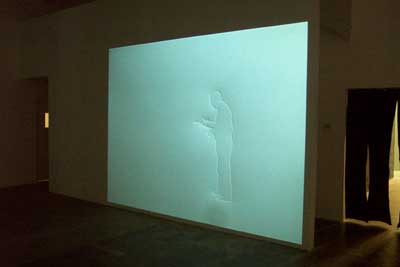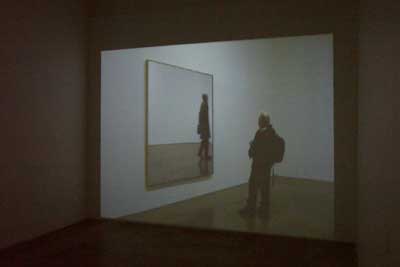
SHIN-IL KIM
Saltworks Gallery, Atlanta, GA April 16 – June
4, 2005
Craig Drennen
This polished exhibition of three new video pieces is Shin-Il Kim’s second solo show at Saltworks. The press release for the exhibition begins with an extended quote from Clement Greenberg regarding Modernism’s “…use of the characteristic methods of the discipline to criticize the discipline itself, not in order to subvert it, but in order to entrench it more firmly in its area of competence.” The uncited quote comes from Greenberg’s 1960 essay Modernist Painting and is a peculiar way to frame the experience of Kim’s work. It’s made to seem as if Kim’s three pieces, Thinker and Painter from 2004 and In Between from 2005,exemplify the ongoing Modernist search for self-referentiality. They don’t. To Kim’s credit, he is able to use a reductive artistic vocabulary—informed by modernism, to be sure—to reach far outside the internal logic of video.
Kim arrives at this point in his career in what would appear to be the perfect trajectory for an emerging artist. He received a BFA from Seoul National University and an MFA from the School of Visual Arts in New York City, before spending a summer at Skowhegan and proceeding through the Arts In the Marketplace program at the Bronx Museum of Art. He’s been awarded many residencies, including Smackmellon in Brooklyn, and one at the Lower Manhattan Cultural Council. He is currently an artist in residence at the Kunstlerhaus Bethanien International Studio Program in Berlin. There was a time not long ago when the only contemporary Korean artist in common Western parlance was Nam Jun Paik. That situation is clearly changing, as a new generation of energetic Korean artists forge international reputations on several fronts. Nikki S. Lee and Do-Ho Suh both come to mind, and Shin-Il Kim’s name is appearing increasingly on such lists.
That said, the exhibition—designed by Saltworks director Brian Holcomb--favors the alert viewer. The first piece encountered upon entering the space is Thinker, a nice gesture in that it privileges thought from the onset. Here Kim has a 13-second looped animation of the embossed outline from Rodin’s sculpture of the same name. The stop-motion technology allows Kim to create the illusion that the drawing is steadily rotating in space, a tireless syncope that is frozen but always moving. Thinker is also the only piece in the show that is not projected onto a wall. Instead Kim projects it onto a screen mounted on a pedestal. It’s an ironic gesture in that a video piece that references one of the most widely recognizable sculptures would, like a traditional sculpture, be placed on a pedestal.

The next piece encountered, as one moves counterclockwise around the main Saltworks gallery space, is Painter. It is projected expansively onto the wall. It’s worth noting that improvements in technology have allowed video art to be projected to a degree that it can achieve the visual impact of grand scale painting. (First generation video art from the 1970’s now looks as constricted as a lunette panel by comparison.) Painter is a one-minute embossed outline animation loop that uses stop-motion sequencing of over 700 drawings of a man painting. The gallery information states that the source footage was derived from a man copying a painting at the Metropolitan Museum of Art. However, the mention of copying seems more like a red herring tossed out to give theory hounds the illusion of firm footing. What you witness in Painter is not copying, but the extended range of tiny delicate movements that comprise the act of painting. Kim is careful to indicate neither the source image for the painter, nor the surroundings. Instead, he foregrounds the “action” of painting at the scale of Action Painting. The result is a fragile, refulgent shell of an activity made tender and absurd by the projected blankness surrounding it. Again, it is in many ways ironic that such a nuanced meditation on painting (made visible through voluminous drawing) has been executed, not by a painter, but by a media artist.

The final piece is In Between and uses straight footage for its effects, though it might be the most conceptually complex work in the exhibition. In it an older man with a backpack and the appearance of a common citizen stares at a flat screen where a more formally dressed man looks intently at a work off screen. It is tempting to read these characters, in fact the whole scene, as a collecting tray of signifiers. The meaning of the signifiers is dependent on where your attention lingers. The difference in the men’s clothing could be read as a comment on class hierarchy in the arts. Or the clothing differences could underscore the tendency of the “non-art” audience to look first at the critic or connoisseur, who actually looks more actively at the art. The age and gender of the characters might suggest that the gallery and museum is a closed loop of patriarchy, where men observe and support the activities of other men. And so on. The polyvalence of In Between allows multiple interpretations but not infinite ones, and is a testament to Kim’s skill at using restricted visual means to shunt viewer attention right where he wants it. And that’s what makes him no closer to being a Greenbergian modernist than Felix Gonzales-Torres or Charles Ray. Kim himself acknowledges the influence of Buddhist practice in his work and has said that part of the reason he moves from video to drawing and back again as “…a way to transfer to objects the idea of existence and non-existence together at the same time.”
When you step back and examine the entire exhibition, it becomes clear that the engine that drives Shin Il Kim are the basic ontological questions of art: thinking, making, and looking. Thinker, Painter, and In Between address these questions respectively in a manner that is good to see in contemporary art, and especially good to see in Atlanta.

Craig Drennen is an artist living in Savannah, GA.